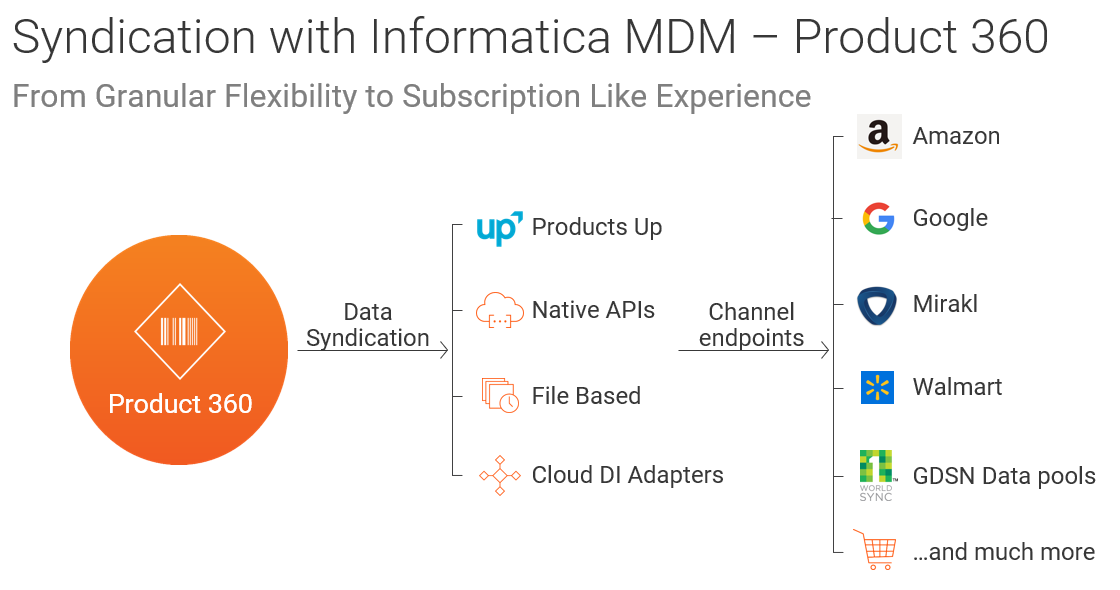Product Content Syndication: Streamlining Commerce With the Best Information at the Right Time

With the significantly accelerated shift towards digital commerce, retailers, brands, and manufacturers are marketing and selling their products across more different channels and marketplaces as never before. Product content syndication requirements have needed to evolve as well, both to meet the challenges of scale and increased channel complexity and to deliver an engaging and informed customer experience.
There are different channels where product data is distributed:
- Owned channels, like your organization’s online shop, catalog, or app.
- Third-party channels, which include:
- Marketplaces and e-commerce platforms such as Google, Amazon, Zalando, Alibaba.com, eBay, Walmart, and others
- Social media platforms such as Facebook or Instagram
- Comparison pages like Google Shopping
- Global Data Synchronization Networks (GDSNs) like 1WorldSync or atrify
To successfully market and sell products, each of these channels need to be fed with product information and digital assets that are accurate, relevant, and rich. And when third-party channels distribute product data, that’s called product content syndication.
Each marketplace defines their own channel-specific criteria for participating brands and retailers. This involves many different rules defined per channel/target for product data, which in turn frequently results in ongoing, high-volume data maintenance and validation efforts for brands and retailers prior to syndication. Factor in the frequent change requirements for product data structures and formats, and it’s easy to see how keeping data exports across the board up to date can be very time consuming.
Although selling across multiple different channels is an opportunity, there is also a high risk of inconsistent data, missed sales opportunities, and slow time-to-market if you fail to comply with product content syndication criteria for an ever-growing number of channels that reach across different markets and addressing target markets with different languages.
Addressing Complex Product Data Syndication Requirements
Because this growing number of marketplaces will continue to play an increasingly important role, selling products online has become ever more data-driven and complex. Frequent changes to structures and requirements have made keeping data exports up to date with latest releases much more cumbersome.
And since each channel is not a single layer, it has market-specific criteria, where data needs to be maintained and validated before export. Meaning that each channel is multiplied by the number of markets you want to reach.
The need for effective product content syndication has grown as well. To successfully streamline your product content syndication, you’ll need to know how many third-party channels, in how many different target markets, and in how many languages you must feed with product data. That information will give you a better idea of how you’ll need to invest in your capabilities to optimize product content syndication.
Do I need a PIM for product content syndication?
Before syndicating product data to your channels, it’s important that it is clean, relevant, and enriched. Typically, this is mastered centrally using a Product Information Management (PIM) solution with embedded data quality checks. Without a PIM, you risk syndicating poor product data with third-party channels, resulting in a bad brand- and consumer experience.
Product 360 provides several product content syndication options to retailers, brands, and manufacturers, for various needs and use cases. Options include Cloud DI Adapters, file-based syndication, native APIs, and syndication with Productsup.

Extending Syndication Capabilities
To help B2B and B2C customers meet ever-evolving and more complex product content syndication requirements of B2B and B2C customers, Informatica is extending their capabilities and is now partnering with Productsup, a leading product-to-consumer (P2C) platform that empowers brands, retailers, service providers, and marketplaces to master commerce anarchy and win product orders over and over again.
“Product information management and content syndication requirements have accelerated with the significant shift towards digital commerce. With the Product-to-Consumer platform from Productsup and Informatica MDM - Product 360, companies can efficiently manage and syndicate rich product information to their sales and marketing channels across multiple countries and languages to drive engaging product experiences,” says Manouj Tahiliani, GVP & GM, MDM & Business 360 Solutions at Informatica.
“I am excited about the partnership between Informatica and Productsup. By combining Informatica Product 360 and the Productsup platform, companies gain more value from their engagement with their customers. Creating an environment where rich, accurate, complete, and timely product information can be delivered to the omnichannel world effectively and efficiently”, says Saskia van de Ven, Senior Vice President, Partners at Productsup.
Using Productsup to syndicate trusted and enriched product data from Informatica Product 360 lets brands and retailers successfully manage both scaling and complex PIM use cases as well as data feeds to their sales and marketing channels, across multiple countries, in multiple languages and on multiple marketplaces, leveraging a portfolio of 2,500+ pre-configured export templates to get faster on new channels.
To learn more, download your copy of the IDC MarketScape 2021 Vendor Assessment: PIM for Commerce.








